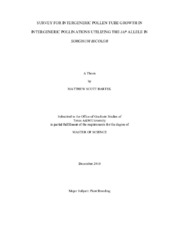| dc.description.abstract | Hybridization within Sorghum bicolor (L.) Moench has been the primary means of creating genetic diversity needed for sorghum crop improvement. While significant variation exists within S. bicolor, there are several traits that can be improved and potential opportunities to improve S. bicolor if secondary and tertiary germplasm pools could be accessed. Recently, the discovery of the iap (Inhibition of Alien Pollen) mutant and its introgression into more breeding-amenable genetic background has facilitated the development of S. bicolor germplasm with genetic diversity not previously seen within Sorghum. The key to producing this variation is the homozygous recessive mutant gene iap which removes an important reproductive isolation barrier to hybridization. Development of a S. bicolor accession (Tx3361) containing the mutant allele iap and ms3 has allowed introgression of genomic regions from divergent sorghum species into S. bicolor. Given the success with divergent sorghum species, there is a real interest in assessing the potential of this mutant to facilitate intergeneric hybridization. The objective of this study was to determine the range and effectiveness of the iap mutant to allow pollen tubes of Poaceae species outside of the genus Sorghum to grow into S. bicolor pistils. Accessions from the genera Zea, Miscanthus, Pennisetum, and Sorghastrum were used as pollen donors onto Tx3361 and fluorescent microscopy was used to determine the distance through the pistils that foreign pollen tubes grew. Results indicate high levels of pollen tube growth into the ovaries of S. bicolor pistils for two accessions of Pennisetum ciliare (L.) Link and four accessions of Zea mays L. Pollen tubes of other accessions tested did grow to the ovary but in very small numbers. While the recovery of embryos was not attempted in this study, the results indicate that there is potential for hybridization, but the specific pollinator within a species is critical in this attempt. | en |


